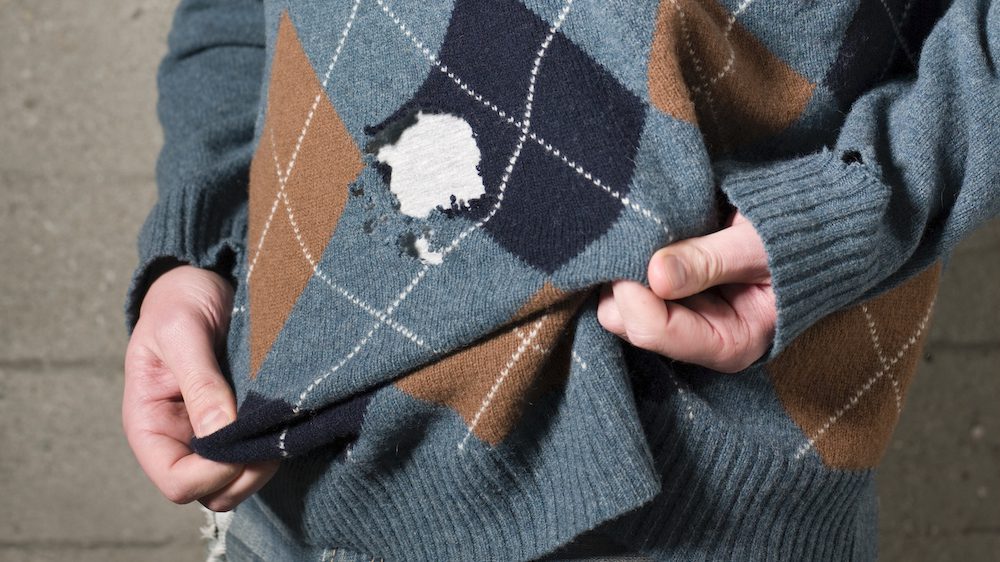
Stewart Sutton/Getty Images
You put on your favorite cashmere sweater only to find a big hole chewed through a sleeve. You go downstairs to get a snack from the pantry, and a moth quickly flutters toward you. It looks like you have a moth problem—and you may have had it for a while.
Even if you don’t see them, moths can infest a home long before you notice their presence.
“Most species of moths—and their less diverse relative, the butterfly—are not pests,” says Scott Schell, an entomology specialist at the University of Wyoming Extension. “They are, however, considered nuisance pests because of their behavior.”
Experts say there are two categories of moths that are more likely to make an appearance in your home: clothes moths and pantry moths. And while both are harmless, their presence is likely to cause you a lot of annoyance.
So how do you keep these fuzzy little insects at bay? Here are some actions to take inside your home.
Regular housecleaning
One of your daily tasks should be wiping down surfaces to get rid of dust, crumbs, and fibers. Pantry moths love to snack on loose breadcrumbs, cereal, and even flour, so make sure you’re keeping your countertops and shelves extra clean.
Vacuum floors and carpets weekly, and clean under and around tables and furniture. Make sure to throw out the vacuum bag as soon as you’re done.
Mind your pantry
Prepare yourself for a gross bit of information: Pantry moths can lay eggs in staples like flour, cereal, beans, dried fruit, and dog food. You might notice the presence of larvae in the form of webs, cocoons, or droppings inside your snacks. Ick!
“To prevent pantry moth infestations, put grain-based products and pet food in containers made of glass, tightly sealed metal, or hard plastic,” says Judy Black, vice president of quality assurance and technical services for pest control company Rollins Inc.
If you find evidence of their presence, throw out all contaminated goods.
And be sure to wipe down your pantry with water and vinegar or soap and water about once every couple of weeks.
Close entryways
Help keep moths outside by keeping doors closed and repairing holes in window screens. Schell recommends checking screen and/or storm doors, window screens, and weather seals around garage doors for cracks.
Moths can also get into your home by bumming a ride on clothing, furniture, or items bought from thrift stores, so it’s important to inspect those items before bringing them inside the home.
And consider using outdoor lighting sparingly.
“Lights are a significant moth attractor around the home at night. If outdoor lighting is essential, try to place it slightly away from the door,” says Black.
Carefully store your clothes
Clothing moths are nocturnal, so they do their business in the dark. To keep moths from chomping on your cherished clothing, store clothes in vacuum-sealed bags. Moths especially like wool, linen, silk, and fur.
Hard plastic storage containers can also give fabric an added layer of protection.
“When putting away seasonal clothes for the winter or summer, ensure the items are clean when they go into storage. This goes for any type of fabric,” says Black.
Consider washing your everyday clothing in hot water, unless you’re worried about their shrinking. You can also dry-clean your clothes to kill any moth larvae.
And make sure to vacuum your closet thoroughly, because moths love dark corners. Don’t forget your clothing drawers!
Break out the cedar
Ditch the mothballs. The heartwood of red cedar is a major turnoff to moths. Try placing cedar balls ($11.89, Amazon) in drawers, cedar lining in your closet, or cedar rings on hangers to help prevent moths from checking into your home. However, cedar is no magic bullet—you’ll still need to keep your kitchen tidy and properly store your clothes.
And if you cannot rid your home of a moth infestation, it’s best to call the professionals.
The post How To Keep Moths From Ruining Everything in Your Home appeared first on Real Estate News & Insights | realtor.com®.
No comments:
Post a Comment